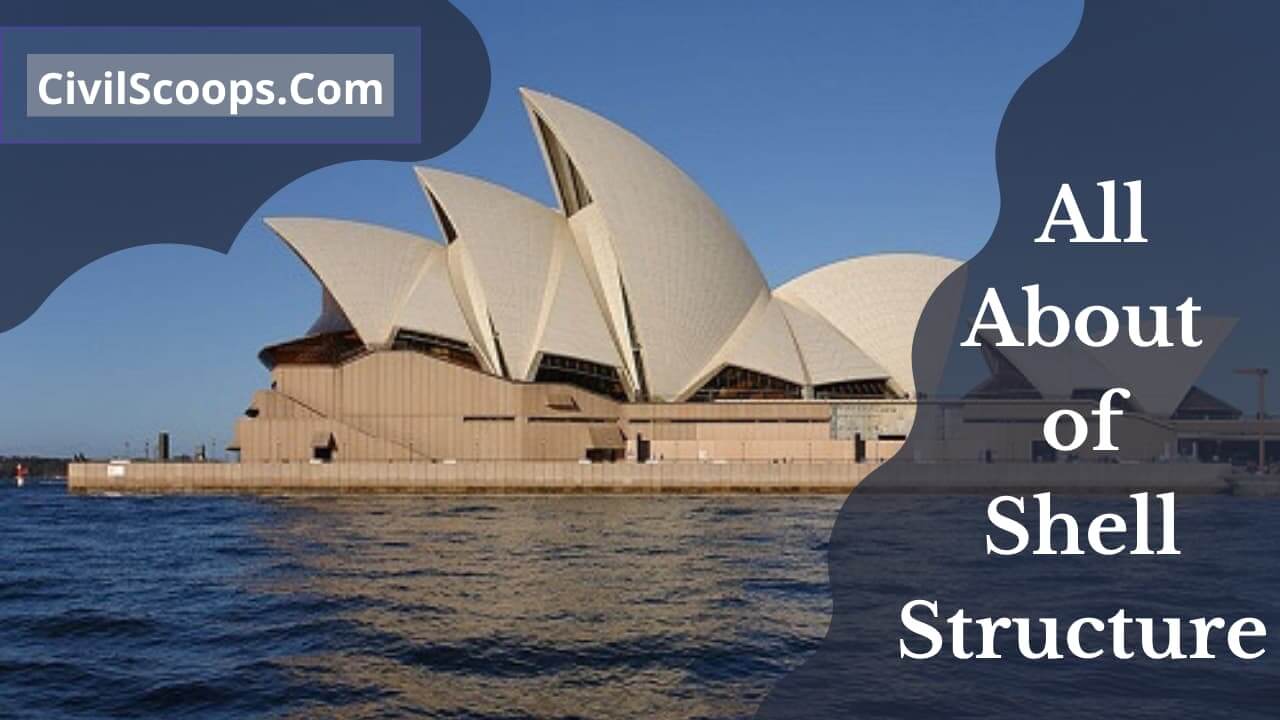What Is Shell Structure | Types of Shell Structure | Applications of Shell Structure | Advantages & Disadvantages of Shell Structures
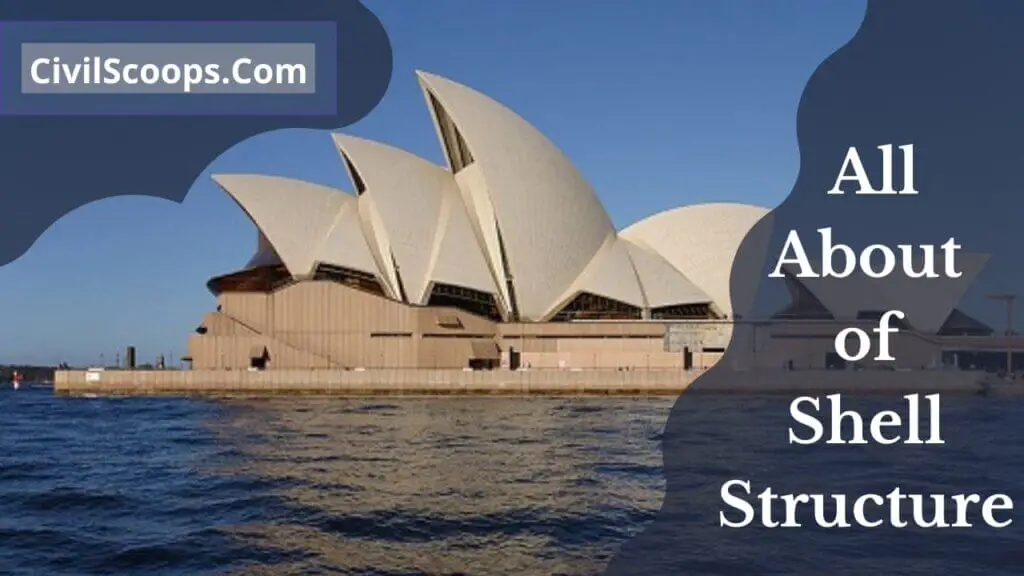
Table of Contents
What Is Shell Structure?
The structure that retains their size and support load, even without frame or solid mass material inside is called shell structure. A shell is a building that is hollow from within, these shell components are usually bent and formed into a massive frame, they are lightweight constructions using shell elements.
A thin shell is known in the shell structure as a shell with a thickness that is smaller than its other dimensions. The deformation in the thin-shell structure is smaller in comparison to the thickness. The key distinction between shell structures and plate structures is that in an unstable state, shell structures have curvature, while plate structures may be smooth.
While flexural deformation can result in secondary forces, membrane activity in shell structures is primarily caused by plane stress. A shell is the most effective way to use the material and can be very useful for fluid and solid storage (uniform loads). The curved shape will result in a variety of failure modes, and unexpected behaviour is not uncommon.
In addition to all other structural types, analytical formulas are very complex and difficult. Shell systems are very appealing low weight structures that are well suited to both building and manufacturing applications.
Types of Shell Structure
Here, the different types of shell structures are as follows.
- Cylindrical Shell
- Multiple Cylindrical Shells
- North Light Shells
- Asymmetrical Cylindrical Shells
- Barrel Vaults
- Short Shells and Long Shells
- Domes
- Intersection Shell Structure
- Shell Arches
- Translation Shells
1. Cylindrical Shell
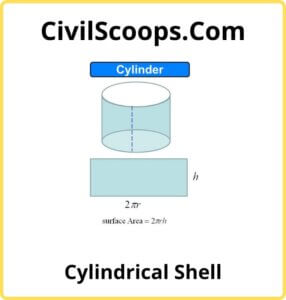
Cylindrical shells are the primary structural component of both aquatic and airborne systems. Frames or ribs are also used to stiffen these structures.
This is a kind of shell in which the stationary cure, known as directrix, or the moving curve, known as generatrix, is a straight line.
Cylindrical shells stiffened on the outside by stringers are economical for axial compression and bending with an active deflection restriction, but uneconomic without one.
Some examples of typical cylindrical shells include the :
- Semi-ellipse.
- Arch circle.
- Cycloid catenary.
- Horseshoe form.
2. Multiple Cylindrical Shells
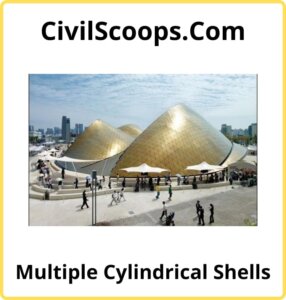
It consists of a sequence of parallel and transversely continuous cylindrical shells.
3. North Light Shells

This shell construction is used to provide vast areas of north light windows for factories that need good natural lighting. Windows may be slanted, as seen here, or vertical. The bottom edge member forms a drainage trough with the curved shell and contributes to the structure’s stiffness.
The successful depth of the shell is not the vertical gap between the two sides, but rather the depth if the shell is laid flat with the circle’s ends on the same horizontal line. As a result, the ranges for a north light shell must be relatively short in relation to the vertical depth of construction.
Concrete struts acting as mullions between the window glazing can connect the edges of neighboring shells. The north light shell is described as a shell with two springing at different stages. The supply of curves at various stages towards the north provides optimum north-light ; this kind of shell is typically used as a roof in the case of factories.
4. Asymmetrical Cylindrical Shells
This shell arrangement is asymmetrical across the crown.
BARREL SHELLS: A barrel shell is a collection of very thin arches that have the same compressive power. Because of this compressive force interaction, the barrel shell will withstand very large quantities of weight as long as the weight is spread proportionally. However, barrel shells with a constant thickness are extremely vulnerable to concentrated loads.
The barrel shell is shaped similarly to the arch, with a sequence of segmented lines transferring compressive load to the soil; the much more differentiated lines, the stronger the fluidity of the curves mostly on arch or shell. The crown of this kind of shell is symmetrical.
5. Barrel Vaults
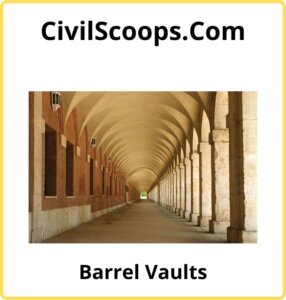
A barrel vault is indeed a continuous vaulted form that could be semi circular in shape, resembling the roof of a cave, or pointing at the apex.
It is usually built by a sequence of edge arches or vaults via a continuous shield. Since of their greater span capability of up to 50 m with minimum material, these are also most suitable for shell structures.
6. Short Shells and Long Shells

A variety of terms have been originally used to describe cylindrical shells, based on whether their period is short or long. Short shells : Short shells are those with a short period length.
Long shells : Where the period length is greater than the width, the shell shape is referred to as a long shell.
7. Domes
A dome is a structure framework that occupies an area that is somewhat square or circular. The domes are connected to a surface formed by some curve rotating around a vertical line. Whenever the ground has a dual curvature that results in a hard and solid snoring shell structure instead of a curved surface.
8. Intersection Shell Structure
The angle of collision of the design of a system the structural effectiveness of the intersections shell. A rib fomented by neighboring elements of the initial shell is so much greater than that of the neighboring shell on either side unless the angle is wide.
So if the angles of intersection becomes too large, it is referred to it as a shallow intersection; if the angle of intersection is 90 degrees, it results in a rigid rib.
9. Shell Arches
Small shells and shell arches are all types of shells. Both thicknesses can be rendered much smaller than an arc if the stresses are mostly compressive. Shells are not a very effective framework for high bending moment values.
10. Translation Shells
A translation shell is created by moving a vertical curve over another vertical curve. Since curves have various forms, such as triangles, ellipses, and parabolas, vertical segments are all the same, as compared to a circular sphere, where vertical segments vary in height.
In a nutshell, a translation shell is a square dome whose form is formed by a curve moving along another curve. Since the arch shape is used to minimize tension and thickness in the transverse direction, barrel vaults are very effective structures.
Also Read: Building Layout | How to Building Layout | Construction Layout Techniques
Applications of Shell Structure
- The shell construction is common in both nature and classical architecture.
- Shells are used mostly in two ways in civil engineering: industrial systems such as
- Silos, reservoirs, cooling towers, and reactor vessels, and ,
- Decorative and architectural special structures.
- The fuselages in airplanes.
- Halls for boats .
- Any buildings have roof frames.
Shell Structure Examples

- The world-famous thin-shell building, the Sydney Opera House, has spectacular architectural views.
- In India, the Lotus Temple in Delhi is a fine example of a shell structure, and numerous shell structures demonstrate the miracle of building construction history.
- Steel reticulated dome :
- Expo 67 Montreal, United States Pavilion is the 250 foot diameter by 200 foot high dome approximates a three-quarter sphere, while geodesic domes prior to 1967 were hemispherical.
- Steel pipes and 1,900 acrylic panels make up the dome.
- To keep the indoor temperature manageable, the concept used mobile triangular panels that moved around the inner surface in the direction of the light.
- This element, though genius on paper, was too innovative for its time and never performed.
- Aluminum alloy reticulated dome : Spruce Goose dome, Long Beach, USA.
- Timber-steel free form grid shell : Multi-hall, Mainz, Germany.
- The multi-purpose dome for the 1975 garden show spans maximum of 60m with 50 x 50 mm twin wood slats of 50 cm squares that deformed into rhomboids.
Also Read : Types of Wood
Advantages & Disadvantages of Shell Structures
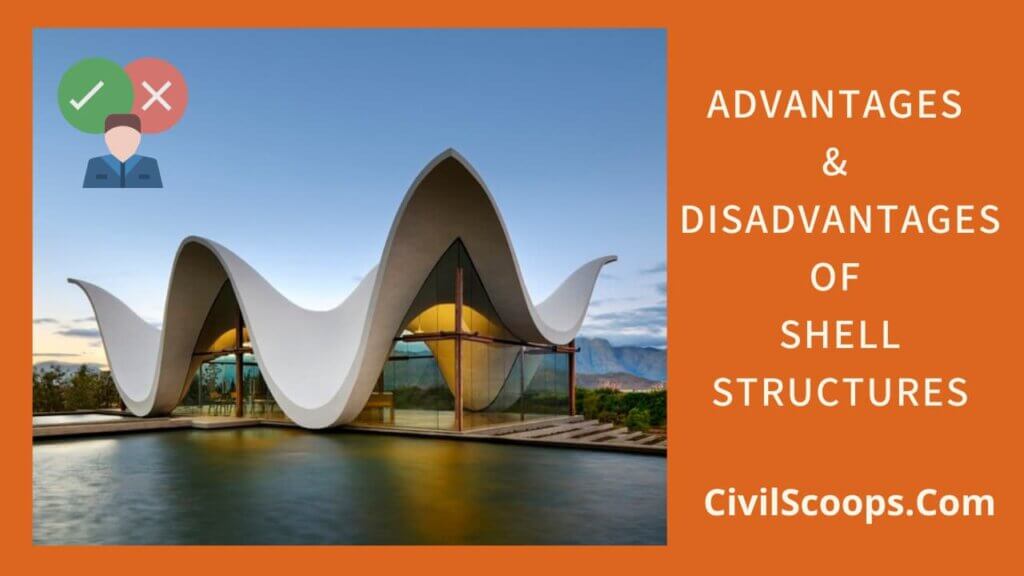
Advantages of Shell Structures
- Curved forms are inherently solid pillars that allow for large areas to be span without the use of internal supports, resulting in an open, unobstructed interior.
- Since concrete is comparatively cheap and readily cast onto compound curves, using it as a building material eliminates both material and construction costs.
- The resulting construction can be extremely strong and safe; for example, modern monolithic dome houses have withstood hurricanes and fires.
- High power in relation to its own weight. ( Major efficiency measurement criteria ).
- Extremely Stiffness Protected
- a large area reduces building costs
- Aesthetic worth.
Disadvantages of Shell Structures
- Since concrete is a porous substance, concrete domes sometimes have sealing problems.
- Rainwater will seep through the roof and spill into the building’s interior if it is not handled.
- The smooth structure of concrete domes, on the other hand, prevents air from escaping which can contribute to condensation accumulation on the interior of the shell.
- Exterior moisture is commonly addressed with shingling or sealants, and condensation may be addressed with dehumidifiers or ventilation.
- Since concrete is a porous material, seepage can occur.
- It is not necessary to put another floor above it due to its geometry.
- It is essentially the roof covering framework.
[su_box title=”FAQ” style=”default” box_color=”#333333″ title_color=”#FFFFFF” radius=”3″ class=”” id=””]
Crystalline
A crystalline substance is in the form of crystals or contains crystals. Diamond is the crystalline form of the element carbon. Crystalline means clear or bright.
Structure of Fatty Acid
Generally, a fatty acid consists of a straight chain of an even number of carbon atoms, with hydrogen atoms along the length of the chain and at one end of the chain and a carboxyl group (―cooh) at the other end. It is that carboxyl group that makes it an acid (carboxylic acid).
Cabling
Network cables are used to connect and transfer data and information between computers, routers, switches and storage area networks . These cables are essentially the carrier or media through which data flows.
Word Structure
1. Word structure – the admissible arrangement of sounds in words. Sound structure, syllable structure, morphology. Structure – the complex composition of knowledge as elements and their combinations; “his lectures have no structure” affixation – the result of adding an affix to a root word.
Hexagonal Crystal System
Common hexagonal crystals:
apatite. Aquamarine. Beryl.
Cancrinite. Emerald. Goshenite.
Morganite. Sugilite. Zincite.
Social Structure
Social structure refers to the pattern of social relationships in a society. Such structure regulates the interactions among members of the society, providing guidelines within the cultural norms for achieving the goals defined by cultural values. Generally, social structure maintains societal stability.
Parallel Sentence
Parallel structure (also called parallelism) is the repetition of a chosen grammatical form within a sentence. By making each compared item or idea in your sentence follow the same grammatical pattern, you create a parallel construction. Example not parallel: ellen likes hiking, the rodeo, and to take afternoon naps.
Framed Structure
A framed structure in any material is one that is made stable by a skeleton that is able to stand by itself as a rigid structure without depending on floors or walls to resist deformation.
Truss
A truss is a structure that consists of members organised into connected triangles so that the overall assembly behaves as a single object. Trusses are most commonly used in bridges, roofs and towers.
Cofferdam
Cofferdam, watertight enclosure from which water is pumped to expose the bed of a body of water in order to permit the construction of a pier or other hydraulic work. Cofferdams are made by driving sheetpiling, usually steel in modern works, into the bed to form a watertight fence.
[/su_box]
[su_note note_color=”#F2F2F2 ” text_color=”#333333″ radius=”3″ class=”” id=””]
Like this post? Share it with your friends!
Suggested Read –
- Hand Level Surveying | What Is Site Level? | What Is Hand Level? | How to Use a Hand Sight Level | Estimating Distances with a Sight Level
- Types of Cement Grades | Difference Between 33, 43 &53 Grade Cement
- What Is Panelled Window? | What Is Glazed Window? | Difference Between Paneled Window and Glazed Window
- What Is Fresh Concrete? | Properties of Fresh Concrete | Factors Affecting Workability
- What Is Heat Resistance Concrete? | Reinforcement in Heat Resisting Concrete | Properties of Heat Resisting Concrete | Application of Heat Resisting Concrete | Advantages & Disadvantages of Heat Resisting Concrete
- What Is Super Elevation? | Superelevation Definition | Purpose of Providing Superelevation in Roads | Calculation of Superelevation in Roads | Minimum and Maximum Superelevation in Roads | Method of Providing Superelevation to the Roads
- What Is Lintel? | Function of Lintel | Types of Lintel
- What Is Grouting | Type of Grouting | Experiment of Grouting | Characteristics of Grouting | Types of Grout for Ceramic Tile | Advantage of Grouting | Disadvantage of Grouting
[/su_note]
Originally posted 2024-04-05 05:13:59.

